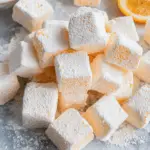The Art of Butterflake Rolls
Butterflake rolls stand out due to their distinct texture and appearance. The process of making these rolls involves creating thin layers of dough and butter, resulting in rolls that are tender, flaky, and buttery with each bite. The dough is prepared using a method that incorporates multiple folds, similar to the technique used in making puff pastry. This lamination process creates the characteristic layers that make butterflake rolls so soft and light. By spreading butter over the dough and folding it repeatedly, the dough develops a delicate, flaky structure that bakes up beautifully. These layers create a satisfying texture that contrasts with the creamy orange glaze, which gives the rolls a unique and luxurious feel.
The Dough: Soft and Slightly Sticky
The dough for Orange Glazed Butterflake Rolls is a slightly sticky yet manageable mixture, made with the perfect balance of ingredients to ensure a tender and soft result. The yeast, activated in warm water, helps the dough rise and develop a light texture, while the addition of butter and sugar gives it a rich flavor. The combination of hot and cold water also plays a crucial role in the dough’s development. The hot water helps activate the yeast and dissolve the sugar, while the cold water slows down the process, ensuring a consistent rise.
Once the dough is prepared, it is allowed to rest in the refrigerator overnight, which not only improves its flavor but also makes it easier to work with the next day. This resting period allows the dough to develop more complex flavors and gives it time to relax, making it much easier to handle during the lamination and shaping stages.
Lamination: The Key to Flakiness
The lamination process is the key to achieving the signature buttery, flaky texture of the rolls. After refrigerating the dough overnight, it is rolled out into a large rectangle and butter is spread across two-thirds of the surface. The dough is then folded in thirds, similar to how puff pastry is prepared. This folding technique creates multiple layers of dough and butter that will expand during baking, creating the desired flaky texture.
Once the dough is folded, it is rolled out again into a large rectangle and folded once more, ensuring that the layers are well distributed. This step is repeated to create even more layers, and the dough is cut into strips that are then shaped into individual rolls. The more layers the dough has, the flakier and more tender the final product will be.
Shaping and Rising: Creating Soft, Fluffy Rolls
After the dough has been laminated and cut into strips, it is shaped into individual rolls that are placed in a buttered muffin tin. The rolls are cut side up, allowing the layers of dough to expand and rise during the final proofing stage. The dough is then left to rise for about three hours or until it feels soft to the touch. This long rise allows the dough to become light and airy, further enhancing the soft texture that makes these rolls so irresistible.
The long rise also helps develop the flavors in the dough, allowing it to ferment slowly and develop a subtle depth of flavor that balances the richness of the butter and the sweetness of the glaze. The dough should not be rushed during this stage, as it needs time to relax and rise properly. When baked, the rolls will puff up beautifully, with layers that pull apart easily, offering a tender, melt-in-your-mouth experience.
Baking: Golden Perfection
Baking the Orange Glazed Butterflake Rolls at 350°F results in a golden-brown finish that perfectly complements the soft interior. The high temperature ensures that the rolls bake evenly and develop a crisp, buttery exterior that contrasts beautifully with the soft, tender inside. The golden color also adds to the visual appeal of the rolls, making them an attractive centerpiece for any breakfast or brunch table.
During the baking process, the butter in the dough melts, creating steam that causes the layers to separate and puff up. This results in a light and fluffy texture that’s not too heavy, despite the rich ingredients. The caramelization of the butter during baking also contributes to the rolls’ flavor, adding a slight sweetness that balances perfectly with the orange glaze.
Orange Glaze: A Burst of Citrus Freshness
The orange glaze is what takes these butterflake rolls to the next level. Made with powdered sugar, orange zest, and fresh orange juice, the glaze adds a sweet, citrusy kick that contrasts with the richness of the dough. The glaze is drizzled over the rolls while they are still warm, allowing it to soak in slightly, infusing each bite with a refreshing citrus flavor.
The glaze not only adds flavor but also enhances the appearance of the rolls, giving them a glossy finish that makes them look even more inviting. The combination of the warm, flaky rolls and the tangy sweetness of the orange glaze creates a perfect balance that will leave you craving more. The glaze is easy to make and can be adjusted to suit your taste—add more orange juice for a thinner glaze or more powdered sugar for a thicker consistency, depending on how you like it.
Versatility: Perfect for Any Occasion
Orange Glazed Butterflake Rolls are incredibly versatile and can be served for various occasions. They are an excellent choice for holiday breakfasts or brunches, as they offer a festive look and a burst of citrus flavor that complements traditional holiday dishes. The light, flaky texture pairs wonderfully with savory options like eggs, bacon, or sausage, while the sweetness of the orange glaze provides a delightful contrast.
These rolls can also be served as a treat for afternoon tea or as a special dessert after dinner. Their soft, melt-in-your-mouth texture and sweet glaze make them a perfect addition to any meal or gathering. You can also experiment with different glazes, such as lemon or lime, if you’re looking to try a new variation of the recipe.
Making Ahead: Ideal for Busy Schedules
One of the best things about Orange Glazed Butterflake Rolls is that they can be prepared ahead of time, making them an excellent option for busy schedules. The dough can be prepared the day before and refrigerated overnight, allowing you to simply bake the rolls the next morning. This makes them an ideal choice for holiday breakfasts or brunches when you want to impress guests without spending too much time in the kitchen.
The glaze can also be made in advance and stored in an airtight container at room temperature. When you’re ready to serve the rolls, simply heat the glaze slightly and drizzle it over the freshly baked rolls for a quick and easy finish.
Conclusion
Orange Glazed Butterflake Rolls are the perfect combination of sweet and savory, offering a melt-in-your-mouth experience with every bite. The tender, buttery dough, combined with the zesty orange glaze, creates a harmonious balance of flavors and textures that will make these rolls a favorite in your household. Whether served for a special holiday breakfast, a casual brunch, or as a treat at any gathering, these rolls are sure to impress. With their ease of preparation and ability to be made ahead of time, Orange Glazed Butterflake Rolls are not only a delicious choice but also a practical one, making them an excellent addition to your baking repertoire.






